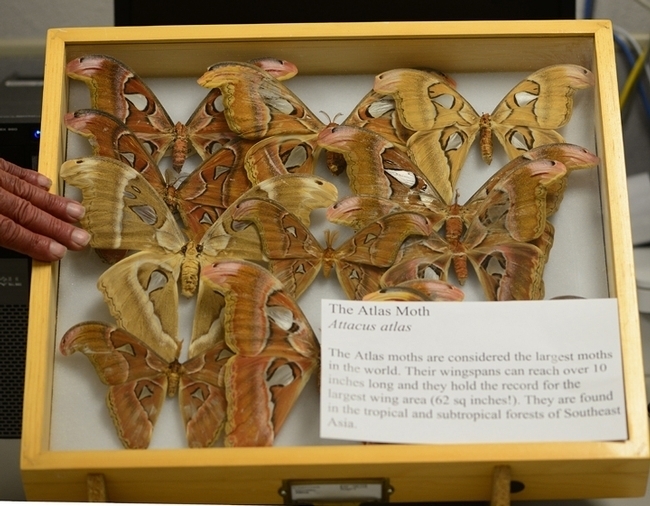
And some of them are quite attractive.
Take the Stiriini moth, Annaphila astrologa.
We saw our first-ever last March in our pollinator garden. Art Shapiro, distinguished professor of evolution and ecology, UC Davis Department of Evolution and Ecology, and naturalist Greg Kareofelas, an associate at the Bohart Museum of Entomology, identified it as a Annaphila astrologa, a small Noctuid.
"It's a medium-sized genus of attractive day-flying moths,” Shapiro said.
It's a species of owlet moth in the family Noctuidae, first described by William Barnes and James Halliday Mcunnough in 1918. A host plant is whispering bells, Emmenanthe penduliflora, a grassland wildflower native to California, according to calscape.org.
Moths and butterflies share the same order, Lepidoptera, but they don't share much else. Moths usually fly at night, not during the day, and moths are generally dull in coloring, compared to butterflies. Moths also outnumber butterflies. Scientists estimate there are some 160,000 described species of moths in the world, as compared to about 17,500 species of butterflies.
Want to learn more about moths? Attend the Bohart Museum of Entomology's Moth Night, set from 8 p.m. to 11 p.m. on Saturday, Aug. 3. It's all free and family friendly. You can:
- View the moths (and butterflies) in the collection curated by entomologist Jeff Smith.
- Talk to the scientists, including senior museum scientist Steve Heydon of the Bohart Museum; Jeff Smith, curator of the the moth and butterfly specimens; and Bohart associates "Moth Man" John DeBenedictis and Greg Kareofelas.
- Check out the display of silkworm moths and silks curated by Emma Cluff. The silkworm moths are from the Bohart Museum collection and the textiles were donated by Richard Peigler, a biology professor at the University of the Incarnate Word, San Antonio, Texas
- Engage in a family craft activity; "kids will be able to color and string white cocoons and make necklaces or bracelets with them," Cluff says.
- Watch the insects that touch down on the blacklighting display, which involves a hanging white sheet illuminated by a generator-powered ultraviolet (UV) light. This won't occur until darkness falls, usually starting around 9 or 9:30.
- Enjoy a cup of hot chocolate and a cookie. (Carafs from Common Grounds Coffee)
- Hold and photograph Madagascar hissing cockroaches and a stick insects (walking sticks), and get up close to the tarantulas, all in the live "petting zoo." There may even be caterpillars on display, according to Tabatha Yang, education and outreach coordinator. They are 3rd instar Antheraea polyphemus larvae, feeding on oak, from West Sacramento. These Polyphemus moths are members of the family Saturniidae, the giant silk moths.
The Bohart Museum houses a global collection of nearly eight million specimens. Founded in 1946 by Richard M. Bohart (1913-2007), and directed by Lynn Kimsey, UC Davis professor of entomology, it is also the home of the seventh largest insect collection in North America; the California Insect Survey, a storehouse of the insect biodiversity; a live "petting zoo" and a gift shop.
The Bohart Museum's regular hours have changed for the summer season. As of July 3, the insect museum is hosting 30-minute tours starting at 2:30 and 3:30 pm. No reservations are required and all ages are welcome. Admission is free, but donations are always welcomed. The Bohart is open to walk-in visitors Monday through Thursday from 1 to 5 p.m. It is closed from 9 a.m. to noon to walk-in visits (the insect museum conducts many tours and outreach programs during those times). More information on the Bohart Museum is available on the website or by contacting (530) 752-0493 or email bmuseum@ucdavis.edu.
Related Link:
- Moths, Smithsonian Institution
Attached Images:
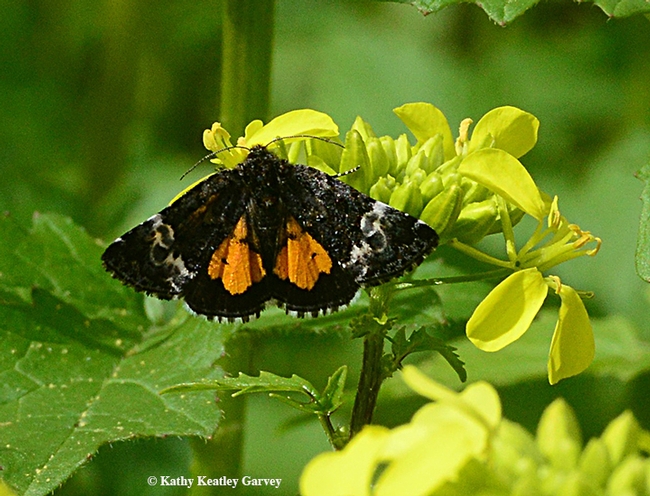
A Stiriini moth, Annaphila astrologa, fluttering in a Vacaville pollinator garden. (Photo by Kathy Keatley Garvey)
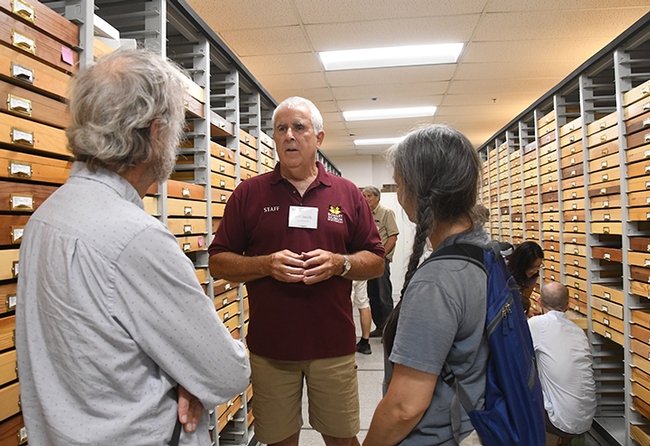
Lepitoptera curator Jeff Smith chats with visitors at last year's Moth Night at the Bohart Museum of Entomology. (Photo by Kathy Keatley Garvey)
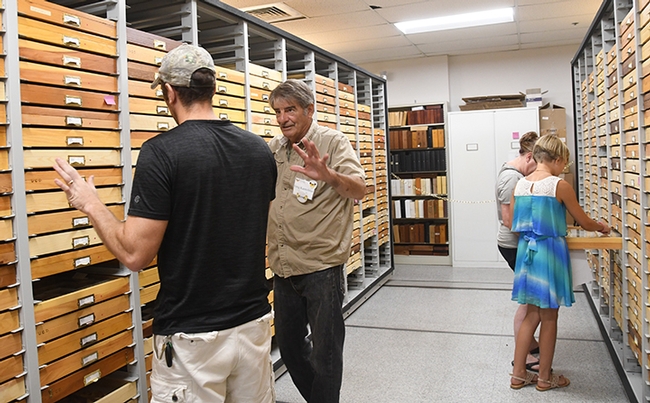
Bohart Museum associate Greg Kareofelas answers a question during the Bohart Museum's Moth Night last year. (Photo by Kathy Keatley Garvey)
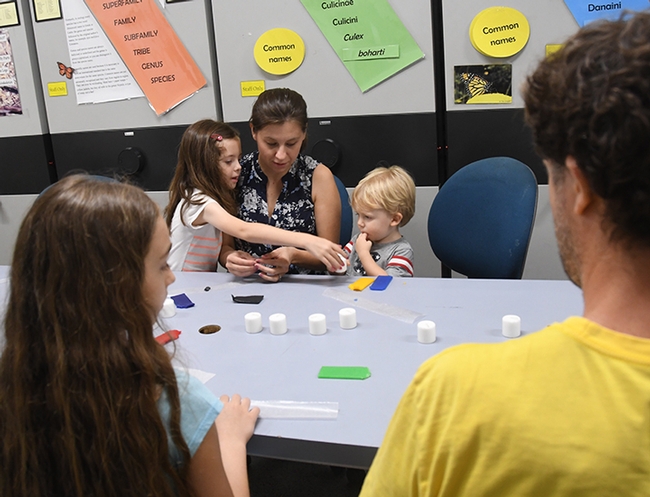
The family craft activity at the Bohart Museum is an opportunity for kids to be creative. This year "kids will be able to color and string white cocoons and make necklaces or bracelets with them," said Bohart associate Emma Cluff. (Photo by Kathy Keatley Garvey)
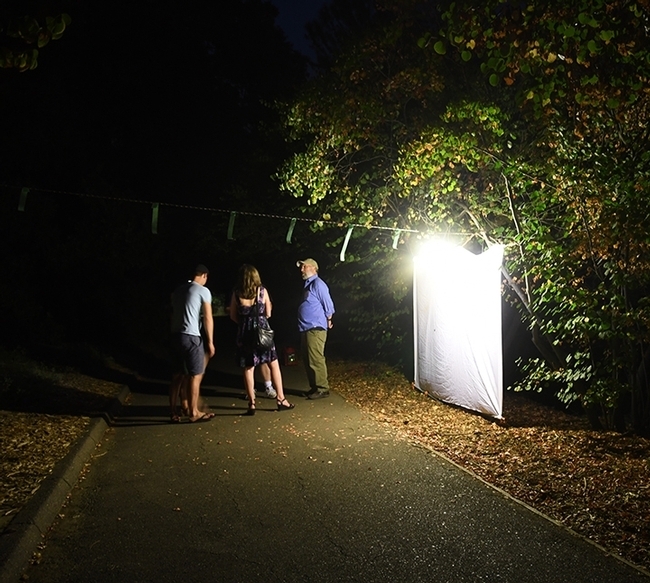
"Moth Man" John DeBenedictis (right) talks to moth enthusiasts at the Bohart Museum's 2018 Moth Night. (Photo by Kathy Keatley Garvey)